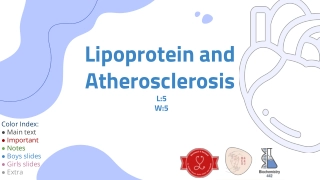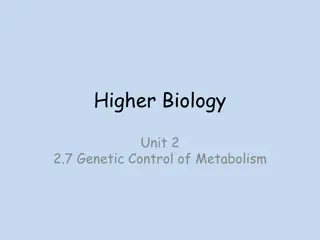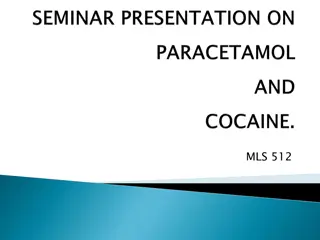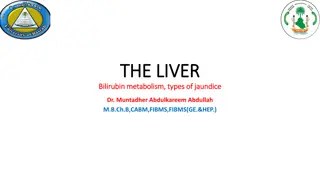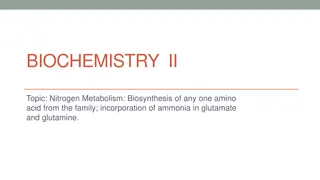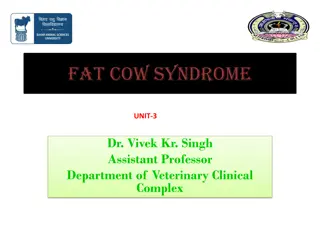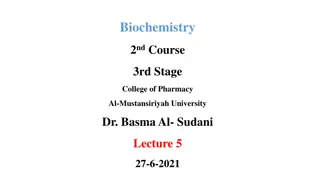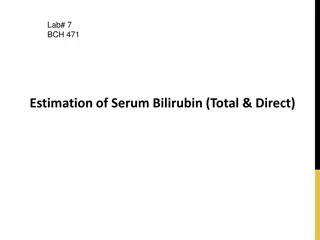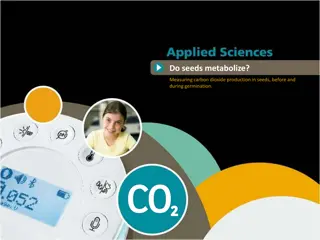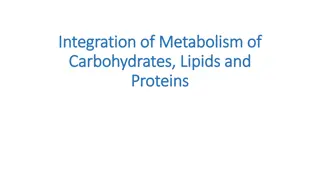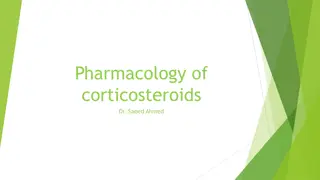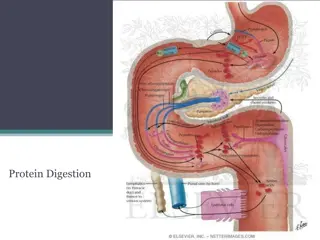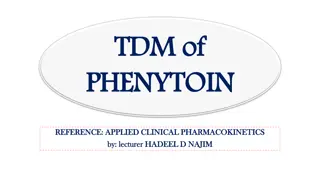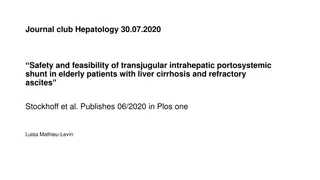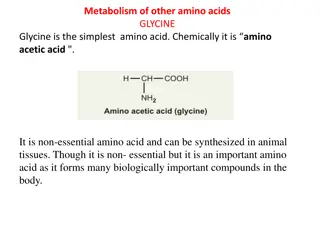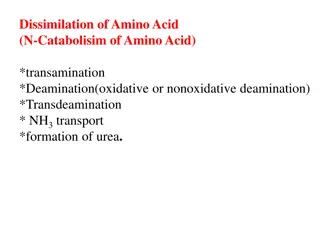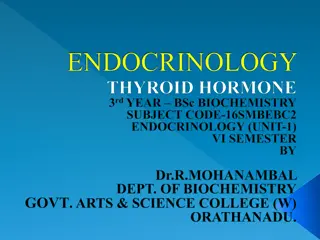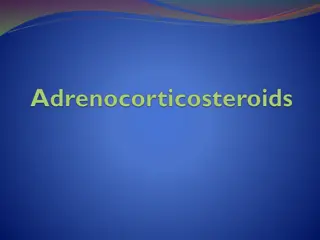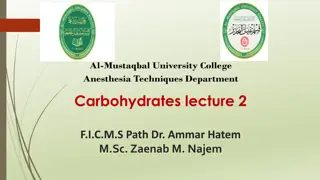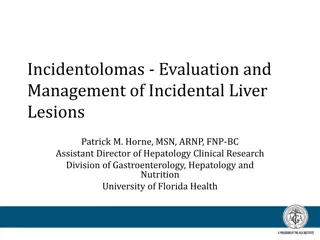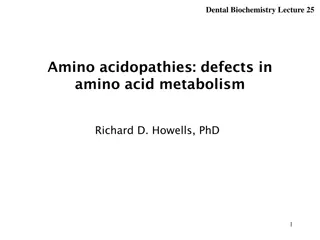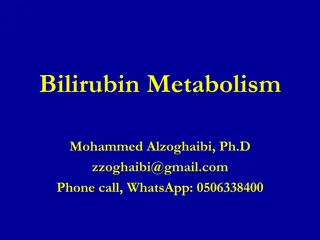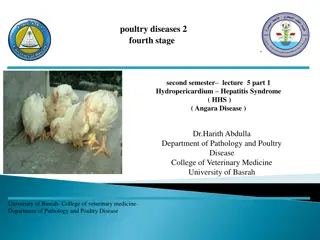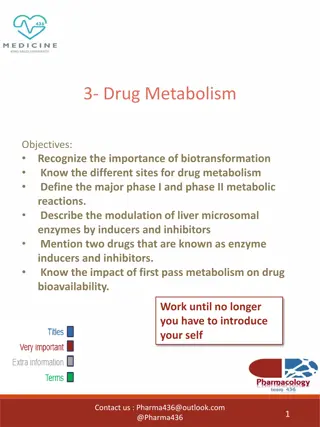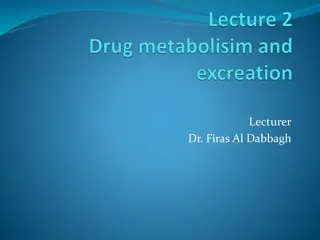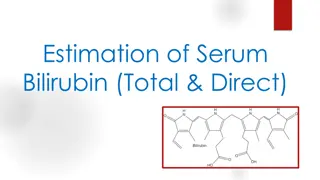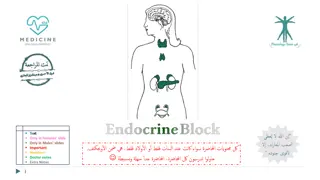Lipoprotein and Atherosclerosis
Understand the correlation between lipoprotein metabolism imbalance and the development of atherosclerosis. Learn about LDL and HDL cholesterol metabolism, receptor-mediated endocytosis, and the role of lipoprotein(a).
1 views • 19 slides
Liver Transplant in India for treatment
Liver is the largest gland in our body, and an important metabolic organ which carries out many essential biological functions. The liver is a wedge-shaped, reddish-brown in color with two lobes of different size and shape. The approximate weight of a human liver is 1.5 kilograms. It is in the upper
5 views • 2 slides
Understanding Pharmacokinetics in Clinical Pharmacology
Pharmacokinetics, as explained in a lecture by Oula Mohammed Sami, M.B.Ch.B/MSc in clinical pharmacology, delves into how the body processes drugs, contrasting with pharmacodynamics which focuses on drug actions. Key topics covered include properties influencing treatment outcomes, the significance
6 views • 45 slides
Genetic Control of Metabolism in Microbes: Enhancing Traits for Biotechnology
Exploring the genetic control of metabolism in microbes, focusing on wild type organisms and the process of strain improvement through mutagenesis, selective breeding, and recombinant DNA techniques. The potential benefits and challenges of altering microbial genomes for biotechnological application
0 views • 27 slides
Understanding Cellular Respiration and Metabolism in Living Organisms
Cellular respiration is a vital process in all living cells, producing energy through chemical reactions. Metabolism, consisting of anabolism and catabolism, maintains growth and function. ATP plays a central role as energy currency in cells. Through stages like glycolysis and the Krebs cycle, cellu
0 views • 16 slides
Protein Digestion and Metabolism in Ruminants and Non-Ruminants
Digestion and metabolism of protein in both ruminants and non-ruminants involve enzymatic breakdown of proteins into polypeptides and amino acids in the stomach and intestines. Key enzymes such as pepsin, trypsin, and chymotrypsin play important roles in protein digestion. Gastric digestion in the s
3 views • 14 slides
Understanding Calcium Metabolism: A Comprehensive Overview
Calcium metabolism plays a critical role in various bodily functions like nerve conduction, coagulation, and bone mineralization. It involves processes such as calcium absorption, distribution, and homeostasis, regulated by hormones like PTH and calcitriol. The balance of calcium in the body is cruc
7 views • 50 slides
Understanding Paracetamol: Usage, Metabolism, and Side Effects
Paracetamol, a widely used non-opioid analgesic, is effective for treating musculoskeletal pains and headaches. This synthetic medication primarily acts in the Central Nervous System and is available in various forms. However, caution is advised due to potential side effects such as rare skin reacti
0 views • 31 slides
Understanding Bilirubin Metabolism and Different Types of Jaundice
Explore the detailed information about bilirubin metabolism and various types of jaundice, including their clinical presentations, etiologies, and management strategies. Learn to differentiate between different types of jaundice based on case scenarios and understand the functional anatomy and physi
0 views • 33 slides
Understanding Nitrogen Metabolism: Amino Acid Biosynthesis and Ammonia Incorporation
Nitrogen metabolism is crucial in the biosynthesis of amino acids such as glutamate and glutamine, incorporating ammonia for various physiological processes. Ammonia is efficiently transported and stored using compounds like alanine and glutamate, playing a key role in the urea cycle. Glutamate, a v
0 views • 22 slides
Understanding Fat Cow Syndrome in Cattle: Causes, Symptoms, and Treatment
Fat Cow Syndrome, also known as Fatty Liver Disease in Cattle, is a condition commonly seen in high-producing cows during the transition period around calving. The disease is characterized by mobilization of excessive body fat to the liver due to negative energy balance, leading to hepatic lipidosis
1 views • 10 slides
Understanding Xenobiotic Metabolism for Biomedical Applications
Metabolism of xenobiotics, foreign chemicals like drugs, food additives, and pollutants, is crucial for pharmacology, toxicology, and disease management. Knowledge allows for beneficial applications such as antioxidant research, pollutant conversion, and drug biosynthesis using transgenic organisms.
0 views • 11 slides
Understanding Bilirubin: Estimation, Implications, and Causes of Jaundice
Bilirubin, a yellow compound in the catabolic pathway, plays a crucial role in health. Estimating serum bilirubin levels is key in diagnosing conditions like jaundice. Elevated levels, above 2 mg/dl, can indicate disease. Jaundice, characterized by skin and eye discoloration, has pre-hepatic, hepati
0 views • 16 slides
Understanding Nasopulmonary Drug Delivery System
Nasopulmonary drug delivery system, utilizing the nasal route for drug administration, offers advantages such as hepatic first-pass metabolism avoidance and rapid drug absorption. This system is beneficial for pharmacologically active compounds with poor stability in gastrointestinal fluids. While i
0 views • 35 slides
Understanding Seed Metabolism: Measuring Carbon Dioxide Production Before and During Germination
Exploring the metabolic processes in seeds, this study aims to compare carbon dioxide production before and during germination. Students will hypothesize and verify using a carbon dioxide SensorLab sensor. Theoretical aspects of plant metabolism, including photosynthesis and cellular respiration, wi
1 views • 22 slides
Understanding the Integration of Carbohydrate, Lipid, and Protein Metabolism
The integration of metabolism involving carbohydrates, lipids, and proteins can be divided into three stages: hydrolysis to simpler units, preparatory stage, and oxidative stage. In the hydrolysis stage, complex polysaccharides, lipids, and proteins are broken down to simpler forms. The preparatory
3 views • 13 slides
Understanding Corticosteroids: Pharmacology and Effects
Corticosteroids, including glucocorticoids and mineralocorticoids, play vital roles in intermediary metabolism, immune responses, and inflammation regulation. They bind to specific receptors in the cell, entering the nucleus to influence gene transcription and protein production. These hormones have
14 views • 32 slides
Understanding Protein Digestion and Amino Acid Metabolism
The process of protein digestion involves proteolytic enzymes produced by the stomach, pancreas, and small intestine. Pepsinogen is activated to pepsin in the stomach, breaking down proteins into oligopeptides and amino acids. After absorption, amino acids are utilized for protein synthesis and as d
0 views • 7 slides
Understanding Phenytoin Therapy - Clinical Pharmacokinetics and Serum Concentrations
Phenytoin, a medication with high protein binding and hepatic metabolism, exhibits saturated pharmacokinetics with a narrow therapeutic range of 10-20 µg/mL for total serum concentrations. Adverse effects vary with serum levels: minor CNS depression at >15 µg/mL, nystagmus at >20 µg/mL, and ataxi
0 views • 55 slides
Safety and Feasibility of TIPS in Elderly Patients with Liver Cirrhosis
Challenging liver cirrhosis management in elderly patients with refractory ascites has high mortality rates, and transplantation is not always viable. Transjugular intrahepatic portosystemic shunt (TIPS) serves as a non-curative treatment option, aiming to reduce portal hypertension. The procedure i
0 views • 17 slides
Overview of Glycine Metabolism and Its Importance in the Body
Glycine, the simplest amino acid, plays a crucial role in various metabolic pathways in the body. It can be converted to important compounds like pyruvic acid, lactic acid, and creates the one-carbon pool. Glycine is essential for heme synthesis, glutathione formation, purine synthesis, and more. In
8 views • 19 slides
Understanding Inborn Errors of Metabolism and Metabolic Disorders
Inborn Errors of Metabolism (IEM) are genetic disorders that disrupt metabolic pathways, leading to substrate accumulation or product deficiency. These disorders can be classified based on toxic accumulation, protein metabolism, carbohydrate intolerance, lysosomal storage issues, energy production d
0 views • 29 slides
Amino Acid Metabolism Pathways: Transamination, Deamination, and Clinical Significance of Transaminases
Amino acid metabolism involves pathways such as transamination, deamination, and the clinical significance of serum transaminases like ALT and AST. Transamination involves the transfer of amino groups, while deamination involves the removal of the amino group. Transaminases are important intracellul
0 views • 23 slides
Decarboxylation Reaction and Biogenic Amines in Amino Acid Metabolism
Decarboxylation is a crucial reaction in amino acid metabolism where CO2 is removed to form biogenic amines, catalyzed by decarboxylase enzymes. Important biogenic amines include tyramine, tryptamine, and histamine, each impacting physiological functions like blood pressure regulation. Aromatic amin
0 views • 25 slides
Understanding Thyroid Hormones and Their Role in Metabolism
Thyroid hormones, including triiodothyronine (T3) and thyroxine (T4), are essential for regulating metabolism, growth, development, body temperature, and heart rate. They are tyrosine-based hormones produced by the thyroid gland, requiring iodine for synthesis. T3 affects various physiological proce
2 views • 17 slides
Understanding the Role of Corticosteroids in Adrenal Function
The adrenal gland consists of the cortex and the medulla, each responsible for secreting different hormones. The cortex produces glucocorticoids, mineralocorticoids, and adrenal androgens, while the medulla secretes catecholamines. Corticosteroids play a crucial role in regulating metabolism, stress
0 views • 18 slides
Decoding Oxidative Decarboxylation and Krebs Cycle in Energy Metabolism
Explore the intricate processes of oxidative decarboxylation and the Krebs Cycle, essential pathways in cellular energy metabolism. Learn about the conversion of pyruvate to acetyl-CoA, regulatory mechanisms, clinical implications, and more. Discover the fates of pyruvate, allosteric regulation, and
6 views • 19 slides
Understanding Carbohydrate Metabolism and Diabetes Mellitus
Carbohydrates play a vital role in energy production through processes like glycolysis and gluconeogenesis. Glucose metabolism involves pathways like aerobic glycolysis and anaerobic lactate production. In diabetes mellitus, there is a disruption in carbohydrate metabolism leading to elevated blood
1 views • 14 slides
Evaluation and Management of Incidental Liver Lesions
Understanding the natural history, evaluation, and management of benign liver lesions is crucial for diagnosing incidental liver findings. Common benign liver lesions include hepatic hemangioma, focal nodular hyperplasia, hepatic adenoma, and hepatic cyst. Differential diagnosis plays a key role in
0 views • 37 slides
Functional Anatomy and Blood Supply of the Liver
The liver is a crucial organ with dual functions and a complex anatomical structure. It consists of hepatic lobes and lobules, where hepatocytes play a vital role in various functions. The liver receives blood supply from both the hepatic artery and portal vein, allowing for essential processes such
0 views • 20 slides
Overview of Amino Acidopathies in Dentistry: Defects in Amino Acid Metabolism
This lecture discusses the various amino acidopathies, including phenylketonuria, albinism, alkaptonuria, maple syrup urine disease, and homocystinuria. It covers the metabolic defects in amino acid metabolism, symptoms, causes, and treatment methods for these disorders. Emphasizing the importance o
0 views • 19 slides
Understanding Methanol Metabolism and Blood Levels
This content discusses the difference between background/endogenous and exogenous methanol, how metabolism of endogenous methanol affects exogenous metabolism, and the impact of exposure to different levels of methanol on blood concentrations. It highlights EPA PBPK models and assumptions regarding
0 views • 16 slides
Understanding Bilirubin Metabolism in Human Body
Bilirubin, a key pigment in bile, is derived from heme breakdown and plays a crucial role in the liver's detoxification process. This article explores the metabolism of bilirubin, its relationship with heme and globin, as well as its excretion steps involving enzymatic reactions and conjugation in h
0 views • 31 slides
Hydropericardium Hepatitis Syndrome (HHS) in Poultry: Causes, Symptoms, and Prevention
HHS is an acute infectious disease in chickens characterized by high morbidity and mortality, excess pericardial fluid, and multifocal hepatic necrosis. It mainly affects broilers and broiler parents, with clinical signs such as sudden mortality, lethargy, and ruffled feathers. Post-mortem lesions i
0 views • 6 slides
Understanding Drug Metabolism: Importance and Mechanisms
Drug metabolism is a crucial process in the body that transforms drugs into forms easily excreted, affecting their efficacy and toxicity. This involves different sites such as the liver, kidney, and plasma, with enzymes in cellular organelles like cytoplasm and mitochondria playing key roles. First-
0 views • 13 slides
Understanding Drug Metabolism and Excretion in Pharmacology
Drug metabolism involves the biotransformation of pharmaceutical substances in the body, primarily in the liver, to facilitate their elimination. This process helps convert drugs into less active forms for enhanced elimination through various reactions in Phase I and Phase II metabolism. Factors suc
0 views • 20 slides
Understanding Drug Metabolism and Excretion in the Human Body
In the realm of pharmacology, the process of eliminating drugs from the body involves hepatic metabolism, biliary elimination, and urinary excretion. Once a drug is introduced into the system, these routes of elimination come into play, highlighting the crucial role they play in drug clearance and e
0 views • 11 slides
Understanding Serum Bilirubin: Types, Estimation, and Causes of Jaundice
Serum bilirubin levels are crucial in diagnosing conditions like jaundice, with total, direct, and indirect bilirubin playing key roles. Excess bilirubin in the blood can lead to jaundice, characterized by yellow discoloration of the skin and eyes. Different types of jaundice, including pre-hepatic,
0 views • 14 slides
Understanding Parathyroid Disorders - Calcium Metabolism and Hormonal Regulation
This presentation covers the functions of calcium, calcium metabolism, bone physiology, and hormonal regulation of calcium metabolism focusing on parathyroid hormone, calcitonin, and Vitamin D. It discusses hypo and hyperparathyroidism in detail, including clinical manifestations and treatment optio
0 views • 15 slides
Understanding Newer Antianginals and Cardiomyocyte Metabolism
Chronic angina is a condition marked by impaired quality of life and decreased life expectancy, primarily due to myocardial ischemia. It is characterized by symptoms like tightness, heaviness, and pressure sensation, often located retrosternally. The pathophysiology involves a mismatch between oxyge
0 views • 73 slides
